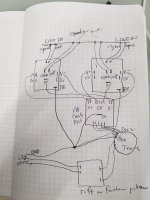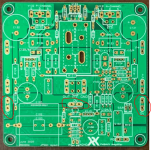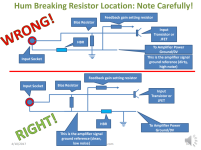Back again, new changes to my list of steps tried in bold. Note that if a step tried didn't remove the hum I undid the change. Also forgot to mention earlier that with my setup, amp powered off, nothing connected to inputs, RCA shields have 10R between them.
- Inputs shorted - no hum
- Inputs connected to each other - minor hum
- Any source (includes battery powered devices such as laptop or phone) connected without line transformers - hum
- Added 22R in series with RCA shield - no change to hum
- Disconnected amp board PE to star ground connection - no change to hum
- Tie RCA jack grounds to each other - still hums but marginally quieter
- Disconnect gnd of one channel - no hum but also no audio from said channel
- RCA jack grounds tied to each other and one channel ground disconnected - hum from channel with disconnected ground
- Added 22R series resistor with RCA shield of single channel - louder hum on channel with 22R, no hum on channel with no 22R
Last edited:
Thanks RickRay, I've been going through that the last day or two but not coming up with much luck, could be I'm dense, could be something else 
- Inputs shorted - no hum
- Inputs connected to each other - minor hum
- Any source (includes battery powered devices such as laptop or phone) connected without line transformers - hum
- Added 22R in series with RCA shield - no change to hum
- Disconnected amp board PE to star ground connection - no change to hum
- Tie RCA jack grounds to each other - still hums but marginally quieter
- Disconnect gnd of one channel - no hum but also no audio from said channel
- RCA jack grounds tied to each other and one channel ground disconnected - hum from channel with disconnected ground
- Added 22R series resistor with RCA shield of single channel - louder hum on channel with 22R, no hum on channel with no 22R
- RCA jack grounds tied to each other, 22R series between RCA shield and input ground - this seems to increase the volume of hum
Well! I have made some leaps in hum. It is now down to a level that is barely audible, but still present when your ear is 6" from the cone, so obviously some work left to do.
I don't know whether to laugh or cry, I thought I was slick using black metal washers and black metal nuts in my chassis. The washers on the SSR boards were shorting the SSR boards ground plane to chassis ground. Remove the washers, hum is almost inaudible.
Now that I have gotten myself down to the almost inaudible hum, should I try bonding the RCA shields directly together?
I don't know whether to laugh or cry, I thought I was slick using black metal washers and black metal nuts in my chassis. The washers on the SSR boards were shorting the SSR boards ground plane to chassis ground. Remove the washers, hum is almost inaudible.
Now that I have gotten myself down to the almost inaudible hum, should I try bonding the RCA shields directly together?
I was going to ask you if you tried using nylon standoffs on the SSR speaker relay protects. A ground short from analog 0v clean ground to chassis dirty ground will cause hum.
The fact that connecting both of the RCA grounds causes hum indicates a signal ground loop.
Look at the wiring diagram on my Alpha Nirvana. See if you have significant changes. There is probably a difference in the SSR PSU section.

The fact that connecting both of the RCA grounds causes hum indicates a signal ground loop.
Look at the wiring diagram on my Alpha Nirvana. See if you have significant changes. There is probably a difference in the SSR PSU section.
Thanks X, giving your diagram a study, I have what I believe are only three minor differences.
- My RCA jack shields are tied together
- 10nF ceramic cap from each RCA shield directly chassis
- My SSR boards are powered by low cap PSU's, low cap PSU's are powered via trafo secondaries, so definitely a difference in SSR PSU, I like the low cap PSU's ability to prevent turn off thumps
- Inputs shorted - dead silent
- Open inputs/interconnected inputs - faintest of hum on woofer if ear pressed on cone, very slight hiss in tweeter (it's not a seashell effect as it's gone if amp powered off but the sound is similar to a seashell sound)
- Battery device (phone) connected - faint hum slightly increases but still need to be pretty close to cone to hear, slight increase in tweeter hiss
- Connect primary source device (Marantz AVR) to inputs - hum and hiss increases hum can be heard from maybe 6" from cone
- Power on primary source - hum and hiss increase, hum can be heard from 10-12" from cone, hiss seems more like a high frequency buzz as it grows in volume
@namghiwook
The three (0)V pinouts are there for convenience. They all serve the same purpose.
Do you have hum from your speaker outputs when you do not have anything connected to your RCA input? The best way to run this test is to short your RCA input. You can use wire, alligator clip leads or a shorting RCA plug, etc…
Do you have an oscilloscope to measure the hum frequency? Did you measure the DC offset in millivolts on the speaker outputs using your DMM? What is this same measurement when you switch the multimeter to AC mode?
Have you read and applied the recommendations by Andrew Russell/Bonsai from Hifisonix for eliminating hum? Read post 1503 which has the link. Like Rick says in that post, I think you have cross channel hum since your hum starts when you have both RCA inputs connected to a source, probably a ground loop.
Did you read through Bloqued’s method of solving the hum from posts 1497 to 1507? He eliminated most if not all of his hum except for any hum coming from his source.
Please post pictures of your current build. You may want to make modifications to your build after looking at Bloqhed’s build and reading through Andrew/Bonsai’s document.
Best,
Anand.
The three (0)V pinouts are there for convenience. They all serve the same purpose.
Do you have hum from your speaker outputs when you do not have anything connected to your RCA input? The best way to run this test is to short your RCA input. You can use wire, alligator clip leads or a shorting RCA plug, etc…
Do you have an oscilloscope to measure the hum frequency? Did you measure the DC offset in millivolts on the speaker outputs using your DMM? What is this same measurement when you switch the multimeter to AC mode?
Have you read and applied the recommendations by Andrew Russell/Bonsai from Hifisonix for eliminating hum? Read post 1503 which has the link. Like Rick says in that post, I think you have cross channel hum since your hum starts when you have both RCA inputs connected to a source, probably a ground loop.
Did you read through Bloqued’s method of solving the hum from posts 1497 to 1507? He eliminated most if not all of his hum except for any hum coming from his source.
Please post pictures of your current build. You may want to make modifications to your build after looking at Bloqhed’s build and reading through Andrew/Bonsai’s document.
Best,
Anand.
Anand has good suggestions. Look for inadvertent connections between 0v and dirty chassis ground without a ground loop breaker (NTC etc).I like sound of this amp.
But I'm experiencing some hum.
The wiring of my amp is attached.
When both channel line-ins connected (either from a mobile phone or a preamp), hum occurs.
When only one channel line-in connected, hum doesn't occurs.
Are your RCA jacks 0v insulated from chassis ground? Some don’t have plastic insulator bushing.
Is your speaker output -ve insulated from chassis ground? Try connecting speaker binding post -ve directly to PSU CRC 0v tabs.
Use small dia coax (RG-174 for example) for connections between RCA jacks and input connector on amp PCB.
Try adding ground strap between 0v GND of RCA jack to each other.
Next, try connecting RCA 0v to PSU 0v. This can be defined as the star hub for 0v analog ground.
There is a ground loop between the two amp boards through the ground of the RCA connectors.
The trick is to break that loop. You might even resort to not connecting one of the RCA shields to the amp. Just leave one channel 0v from RCA unconnected.
Great work gentlemen. I will be working on moving my FH9HVX to a new home over the winter. Will be changing wiring and layout of certain components. This trouble shooting of ground problems is going to be immensely helpful for myself and others. Also the amplifier will have it's own dedicated AL pre amp rather than using the pre from my iDecco integrated amp. Looking forward to unraveling my ground issues once the time comes. Patience and perseverance will be required.
Good wishes in your journey.
Good wishes in your journey.
Friends do you happen to have 2 pcb on FH9HVX somewhere? I'm going to build another 2pcs with slight improvements
1, metallized resistors vishay
2, on the input I will use PP as small as possible due to the penetration of vf (WIMA).
3, the choke will be made of 1,2mm (air choke)
4, I'll block that V123, too. (100nf)
Thanks again
1, metallized resistors vishay
2, on the input I will use PP as small as possible due to the penetration of vf (WIMA).
3, the choke will be made of 1,2mm (air choke)
4, I'll block that V123, too. (100nf)
Thanks again
Did you ever resolve your hum issue?The pdf (How to wire a audio amplifier.pdf) shows HBR (hum breaking resistor) location.
It seems that it does not recommend the way of placing a resister between ground of RCA and input ground of amp board.
I have often found the most common source is a ground loop formed by the common ground (shield) of the source (RCA). It allows a ground loop to flow between the two (previously isolated) mono blocks and the common ground of the source (DAC or preamp). It’s like one needs monoblock preamps and DACs as well. Or… use balanced output DACs and preamps and a galvanically isolated input buffer.
One way to eliminate this is to use a DAC or preamp with a galvanically isolated power supply. That is, the 0v reference of the DAC or preamp is floating relative to the mains protective earth. You can do this with a battery powered device, or an isolated transformer powered device (PE not connected to 0v), or a device with an isolated DC/DC power supply.
The BTSB buffers / preamps that I have on my shop use 5kV rated electrically isolated DC/DC power supplies. They can be powered from a 12v wall wart - which is then isolated from the buffer 0v. The BTSB is now a floating device and poses no ground loop threat. Furthermore, if you use the balanced input of the BTSB from a balanced DAC, then use the single ended output of the BTSB to the FH9HVX, you are essentially breaking up any possible ground loop issue in the most common source of ground loop hum for an amp.
I think Anand (@poseidonsvoice) uses a BTSB with his implementation. It’s not a bad idea because it makes the amp very flexible with respect to any inputs (balanced or single ended) and numerous gains (0/6/14/20dB) or custom value is possible - as Anand used on his.
Without using a BTSB, really the only way to unconditionally eliminate input source common shield ground loop is to use passive signal transformers. Those can be pricey and add their own signature to the sound. Typically third harmonic dominant.
I solved this issue with 'Cross Channel Ground Loop Cure #1: Minimize Loop Area!' of https://hifisonix.com/wp-content/uploads/2019/02/Ground-Loops.pdf
- Home
- Group Buys
- FH9HVX - Budget Conscious 100w Class AB for Lean Times



